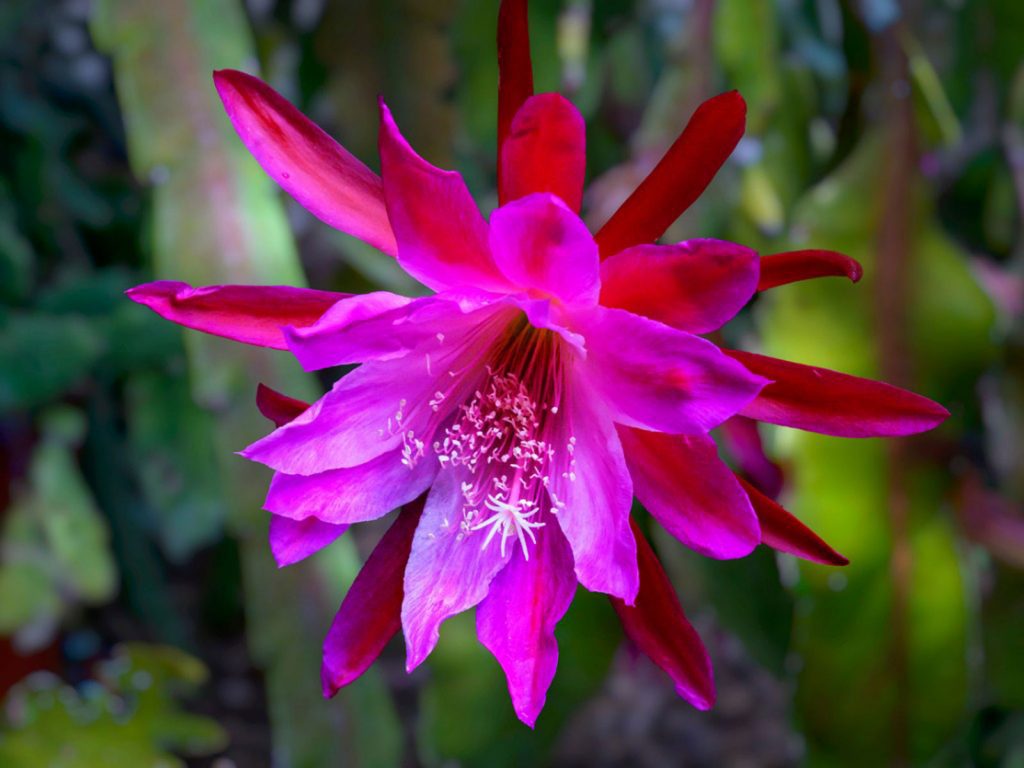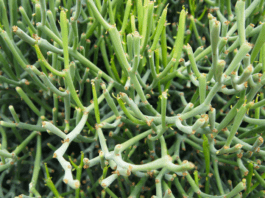Epiphyllum
Epiphyllums are part of the cacti group, but unlike their desert cousins, they cling as ephiphytes to trees in the tropical rainforests of Central and South America.
Several hybrids have arisen from this genus which is extremely suitable for indoor cultivation.
The plants themselves have a rather unattractive habit with sprawling, notched, strap-shaped stems. However, their blooms, which usually appear in the late spring or early summer, are magnificent.
Single or double flaring trumpet-like blooms can be 6in (150mm) across various shades of red, pink, orange, yellow, or white.
Growing Epiphyllum
To ensure Epiphyllums produce these fine flowers every year, the following routine treatment is recommended. Over the winter months, they require a resting period where conditions should be cool, at around 10C (50F), and watering should be kept to a minimum.
As spring approaches, place the plants into a well-lit position but away from direct sun, increase the watering and provide a minimum temperature of 16C (60F).
Flowering buds should soon develop, and at this stage, it is important not to move the plants. At this point, also apply a high potash feed every couple of weeks, continuing until most of the buds have opened.
Having enjoyed those stunning blooms now is the time to place them outside in a shaded position for the summer and bring them indoors again before the onset of frosts.
During this active period, they will benefit from the occasional misting to keep the atmosphere humid.
Repotting, if necessary, can take place after flowering; remembering blooms are encouraged if a specimen is pot-bound. Staking may be necessary to prevent this plant from toppling over.
Propagating
Should you wish to propagate an Epiphyllum hybrid, take stem sections during the summer, allowing these cuttings to dry off for a few days before inserting into compost.
While some people find the plant to be a bit too bizarre and space-hungry the rest of the year, I love it.
Epiphyllums, as the name hints, are epiphytes, like orchids. They live in the rainforest treetops, sending out long snaking tendrils into other trees. They will do this in your home as well, shooting out appendages that will keep going until they hit a wall or ceiling.
The tendrils will turn corners and start into other rooms. I have heard of living room-sized plants, although my own takes up only a modest wall, and they can easily be reined in with some trimming.
Epiphyllum leaves are unusual in that they are modified stems. It appears as if the stem has suddenly decided to flatten out into a wavering bladelike leaf, which can be several feet long.
Other leaves can bud off of these leaves, and the flower shoots come directly off the leaves as well – all in all, one of the strangest botanical arrangements I’ve ever seen.
So, where does the Queen of the Night come from?
Epiphyllum Origins
It originates in Central and South America. As for obtaining one nearer to home, they are traditionally hand-me-down plants. Mine was a single leaf snipped from a friend’s plant and stuck in some soil about 10 years ago.
I had hoped it was something scarce, but apparently, they were trendy in the 1940s, and many of these plants and their offspring are still around. Epiphyllum’s jungle adaptations make them perfect for growing from cuttings. In the treetops, any tendril that is cut or broken becomes an independent plant.
If a hand-me-down is not available, there are many other sources. I’ve seen the Queen at plant sales, and many Internet sites are offering them. Unfortunately, I’m not sure I’ve ever encountered a plant with such a muddled nomenclature.
“Queen of the Night” sounds so good that it seems to be the common name of just about anything that blooms after dark. Another widespread name for this plant is night-blooming cereus.
This isn’t very clear because Cereus is a cactus genus that does not include this plant, and nearly all the Cereus species are night-blooming. Epiphyllum is often sold as Queen of the Night, with Cereus incorrectly given as its scientific name.
If you see a picture of a plant named Cereus that fits the description of the Queen of the Night, you’re probably OK. Otherwise, it’s best to search for Epiphyllum oxypetalum.
As mentioned before, there are many other types of Epiphyllum as well. Do look at pictures before you decide on one. In many, rather ordinary petals replace the reflexing spiky tendrils. The blooms are still stunning, but for me, not quite as unique.
You will also come across Epiphyllum hybrids in different colors. These are unusual hybrids as they are crosses not with a closely related species but rather an entirely different cactus genus.
The true Epiphyllums are always pale because they must glow in the moonlight to attract their pollinators. These, fittingly, are often bats.
Along with their colors, the hybrid Epiphyllums have often taken on the blooming characteristics of the cactuses they are crossed with.
They may bloom in the daytime or for several days. This might seem like an advantage, but for me, it puts a big cabash on the mysterious allure and excitement of the plant.





